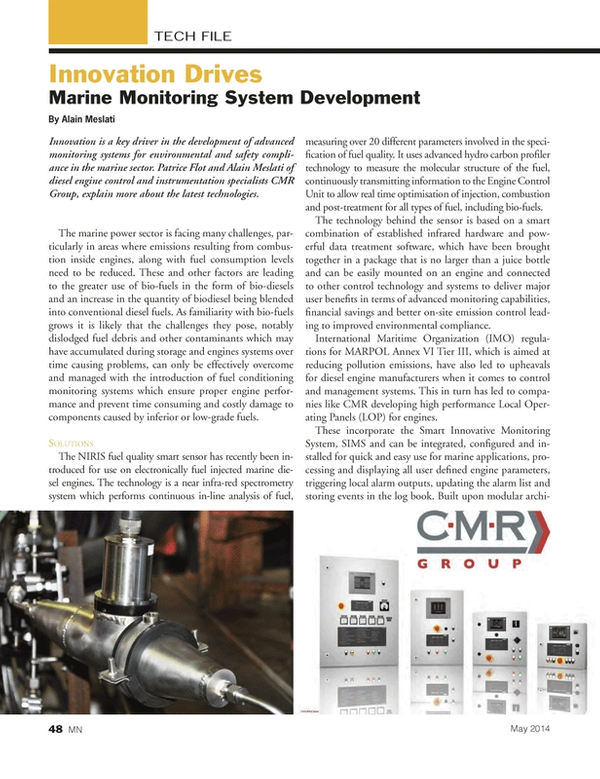
Innovation Drives Monitoring System Development
Innovation is a key driver in the development of advanced monitoring systems for environmental and safety compliance in the marine sector. Patrice Flot and Alain Meslati of diesel engine control and instrumentation specialists CMR Group, explain more about the latest technologies.
The marine power sector is facing many challenges, particularly in areas where emissions resulting from combustion inside engines, along with fuel consumption levels need to be reduced. These and other factors are leading to the greater use of bio-fuels in the form of bio-diesels and an increase in the quantity of biodiesel being blended into conventional diesel fuels. As familiarity with bio-fuels grows it is likely that the challenges they pose, notably dislodged fuel debris and other contaminants which may have accumulated during storage and engines systems over time causing problems, can only be effectively overcome and managed with the introduction of fuel conditioning monitoring systems which ensure proper engine performance and prevent time consuming and costly damage to components caused by inferior or low-grade fuels.
Solutions
The NIRIS fuel quality smart sensor has recently been introduced for use on electronically fuel injected marine diesel engines. The technology is a near infra-red spectrometry system which performs continuous in-line analysis of fuel, measuring over 20 different parameters involved in the specification of fuel quality. It uses advanced hydro carbon profiler technology to measure the molecular structure of the fuel, continuously transmitting information to the Engine Control Unit to allow real time optimisation of injection, combustion and post-treatment for all types of fuel, including bio-fuels.
The technology behind the sensor is based on a smart combination of established infrared hardware and powerful data treatment software, which have been brought together in a package that is no larger than a juice bottle and can be easily mounted on an engine and connected to other control technology and systems to deliver major user benefits in terms of advanced monitoring capabilities, financial savings and better on-site emission control leading to improved environmental compliance.
International Maritime Organization (IMO) regulations for MARPOL Annex VI Tier III, which is aimed at reducing pollution emissions, have also led to upheavals for diesel engine manufacturers when it comes to control and management systems. This in turn has led to companies like CMR developing high performance Local Operating Panels (LOP) for engines.
These incorporate the Smart Innovative Monitoring System, SIMS and can be integrated, configured and installed for quick and easy use for marine applications, processing and displaying all user defined engine parameters, triggering local alarm outputs, updating the alarm list and storing events in the log book. Built upon modular architecture, a LOP operates with acquisition unit and Human to Machine Interface (HMI) modules. They are used for I/O, engine monitoring, controls, pumps, compressors applications and are engineered to ensure marine standards’ compliance and feature technology to manage simultaneously the functions of safety and shut down and condition monitoring, providing the vessel’s crew with a single integrated control system that’s easy to use.
Many Benefits
The benefits provided by this technology are illustrated through two distinct applications: The first one is a vessel featuring a single propulsion engine where the redundancy of the controller is compulsory. In this instance, one of the most important criteria that the LOP has to satisfy is the capability to manage at the same time, and in real time, dual controllers – the CMR device is equipped with two CAN networks, enabling the system to continuously manage the parameters of the electronic control modules (ECM), monitor the communications and display the main controller parameters on the engine.
The second example concerns the numerous requests for simultaneously managing several communication protocols available on engines or ships - CANopen / SAEJ1939 / Modbus TCP/IP / Ethernet which are all embedded on CLARINUX SW, SIMS’ OS allows LOP to manage the communication with engine parameters (T°/Pressure/Speed) through I/O modules, ECM and sometime the propulsion system by reading and writing messages both ways.
LOP systems have been supplied by CMR to many customers of the world’s leading controllers manufacturers including Bosch, Woodward, Heinzmann, Caterpillar and MTU. CMR Group supplies instrumentation and controls for offshore platforms and vessels, marine, engines and industrial applications around the world. With core product groups including rugged cable systems, controls, custom products, electronics, alarm monitoring and safety systems, industrial sensors, and software, the CMR Group is an engineering partner for the world’s leading manufacturers.
www.cmr-group.com
(As published in the May 2014 edition of Marine News - http://magazines.marinelink.com/Magazines/MaritimeNews)
Read Innovation Drives Monitoring System Development in Pdf, Flash or Html5 edition of May 2014 Marine News
Other stories from May 2014 issue
Content
- Talking DP with Aaron C. Smith, Executive Director OSVDPA page: 12
- Arctic Energy Exploration: Not If, But When? page: 20
- There’s No Such Thing as a Routine Grounding page: 22
- The ABCs of EALs for the EPA’s VGP page: 32
- The OPC Sweepstakes: Three for the Money page: 36
- Companies Collaborate to Find Cool Solutions page: 42
- Innovation Drives Monitoring System Development page: 48
- gplink Evolves to Serve the Entire Market page: 50
- Streamlined Service for the Offshore Sector page: 53
- Alion’s MOTISS – IBA: the Science of Survivability page: 58


